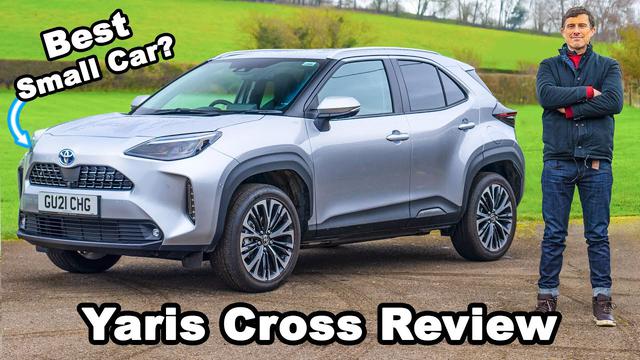The Toyota Yaris Cross was reasonably late to the light SUV party, but that hasn’t stopped it from quickly becoming one of the most popular vehicles in its class.
Toyota sold 7828 units in 2021, second only to the stalwart Mazda CX-3 (12,873 units). The Yaris Cross found more homes than the Kia Stonic (7645 units) and Volkswagen T-Cross (6104 units), both popular rivals.
Other than the Japanese brand’s reputation for bulletproof reliability, the Yaris Cross offers a unique and efficient petrol-electric hybrid drivetrain option as well as dirt-cheap servicing, funky looks, and a range of funky colours.
It’s also offers better value than the Yaris hatchback on which it’s based – ranging from $26,990 to $37,990 it’s in direct contention with rivals on price, while also offering a healthy level of specification across the line-up.
Here on test we have the 2022 Toyota Yaris Cross GXL 2WD Hybrid, arguably the Goldilocks zone in the range. It covers all the spec basics while also featuring an uber-efficient and segment-exclusive hybrid option.
Our mid-spec Yaris Cross GXL 2WD Hybrid on test starts at $31,990 plus on-road costs, a $2000 premium over the non-hybrid GXL and a handy $3000 more affordable than the ‘eFour’ all-wheel drive hybrid version.
That’s right in the firing line of a number of ‘light’ and ‘small’ SUV alternatives, including:
The boot area is a more positive story.
Yaris Cross 2WD models have a quoted 390L with all five seats in place, which is one of the larger boots in the class. If you opt for eFour all-wheel drive, however, that drops to 314L due to the packaging of the rear electric motor, battery, and independent suspension system.
Toyota doesn’t quote a figure with the rear seats folded, but the modular boot floor means you can have a flat load bay with the seats folded or a deeper luggage area for maximum volume in five-seat configuration.
A temporary space-saver spare wheel lives under the boot floor of 2WD versions of the Yaris Cross, while all-wheel versions get a tyre repair kit.
Power in the Yaris Cross Hybrid comes from a 1.5-litre naturally-aspirated three-cylinder petrol engine running the more efficient Atkinson cycle, hooked up to an electric motor and CVT automatic.
System power is quoted at 85kW, but Toyota doesn’t quote a combined torque figure. On its own, the petrol engine develops a modest 120Nm.
Our test car is the front-drive version, though an all-wheel drive model is available with an additional electric motor on the rear axle. The AWD version also swaps out the torsion beam rear suspension for an independent setup.
Fuel use for the Yaris Cross 2WD Hybrid is quoted at an impressive 3.8L/100km on the combined cycle, with emissions rated at just 86g/km of CO2 (combined).
The hybrid will happily run on regular 91 RON unleaded, and the fuel tank measures a teeny-tiny 36L.
Compared to the Urban-spec 2WD Hybrid I drove a year or so ago, the only real difference between that car and this GXL Hybrid is the wheel and tyre package.
The 16-inch wheels and chubbier 205/65 rubber (versus 215/50 R18 in the Urban) mean the Yaris Cross GXL offers a more supple, and quieter ride. It’s all the better for it too.
Where the Urban would occasionally feel sharp or busy on pimpled inner-city roads, the GXL glides over just about everything by comparison, and transmits less road noise into the cabin on the open road.
Otherwise, it’s more of the same. The 1.5-litre hybrid drivetrain features newer hybrid tech than that of the Corolla and C-HR, drawing upon a lithium-ion battery rather than nickel-metal hydride.
I basically hopped into this Yaris Cross after driving the Corolla ZR Hybrid for a week, and I was surprised at how much I preferred the performance of the Yaris Cross as opposed to its stablemate.
For starters, there’s only 5kW separating the system power outputs (85kW v 90kW), and the Yaris Cross in GXL 2WD Hybrid spec is 160kg lighter (tare) than the Corolla ZR Hybrid hatchback. So, it doesn’t have to work as hard to get the same result.
The Yaris Cross seems keener to rely on electrical power than older Toyota hybrid systems, allowing you to accelerate to 40km/h at reasonable pace before the petrol engine kicks in if you’re on flat-ish ground. It not only lifts refinement, thanks to the near-silent nature of e-motors, but also means better real-world efficiency.
We easily managed low 4L/100km (indicated) in mixed real-world driving, with the trip computer dropping into the high 3L/100km bracket with more urban use. It’s a standout in this regard.
You’ll regularly see the ‘EV’ symbol light up in your instrument cluster at a cruise over flat ground, and you don’t really need to change your driving habits drastically to achieve these numbers. If you need to plant your right foot, both the petrol and electric motors come together to offer decent performance up to 60-80km/h, but a traffic light dragster this is not (nor is it meant to be).
As noted earlier, the GXL’s ride is well sorted and pliant in just about any realistic situation, and the comfortable ride doesn’t come at the expense of handling or body control.
Toyota’s TNGA architecture has been commended for its ride/handling balance, and the Yaris Cross’s foundations are no different in TNGA-B guise. The steering is well-weighted and direct, and the vehicle’s compact dimensions and athletic chassis makes for a fun steer.
Remember, the GR Yaris was spawned off the TNGA platform (obviously with modifications), so the fun-to-drive element runs in the Yaris Cross’s DNA.
Being a light SUV, we aren’t expecting S-Class levels of refinement at speed. That said, the Yaris Cross allows an acceptable amount of tyre roar into the cabin, though over smooth surfaces the cabin is very quiet, especially when running solely on electric power.
In terms of assistance system’s, the Toyota Safety Sense suite is definitely a marked improvement over previous iterations.
The lane-keep assist and lane departure warning are much less intrusive that old Toyota systems, and the Lane Trace Assist centring function helps on longer freeway stints given how small the Yaris Cross is.
Blind-spot monitoring and rear cross-traffic alert are good safety nets, though outward visibility is good thanks to the tall glasshouse, and the all-speed adaptive cruise control is a handy feature given traffic-heavy freeway commutes are where this car is likely to spend a lot of its life.
The well-weighted steering combines with the surround-view camera system to make the Yaris Cross an absolute cinch to park, and the sign recognition function is nice to have so you can keep tabs on speed limits.
My main complaint is the voice alert for speed signs and school zones. Go 1km/h (indicated) over the signed limit or enter a school zone out of hours and the virtual lady is incessant in her prompts – finding the ‘off’ switch is a deep dive through the infotainment menus as well.
Still, the Yaris Cross is a very easy car to live with, and the hybrid drive system is seamless. Bravo.
The Yaris Cross is covered by Toyota’s five-year, unlimited-kilometre warranty.
Servicing is required every 12 months or 15,000 kilometres, whichever comes first.
There’s four years of capped-price servicing on offer, with each visit costing $205 over 48 months or 60,000km – making the Yaris Cross one of, if not the cheapest vehicle to maintain in its class in terms of scheduled maintenance.

Our tester was showing in the 4L/100km range in the trip computer, though we saw in the high 3L/100km range with more urban stints. It’s class-leading in this respect.
The Yaris Cross GXL Hybrid makes a compelling case for itself, balancing value with benchmark efficiency and running costs, as well as keen dynamics that make running about the city fun.
It may not be the sexiest or most practical crossover out there, but it holds its own in a hotly-contested segment, as well as offering a pocket-friendly alternative to low-grade small SUVs.
Sure, it’s not that quick and the interior is a bit drab, but it’s all functional and it covers the basics on the spec sheet and then some.
I personally would spend up on the Urban to get the flashier exterior and interior bits, but the GXL Hybrid makes the most sense. Funny how the regular Yaris is so expensive relative to its rivals, but the Yaris Cross is almost ‘cheap’.
Click the images for the full gallery
MORE: Everything Toyota Yaris Cross




